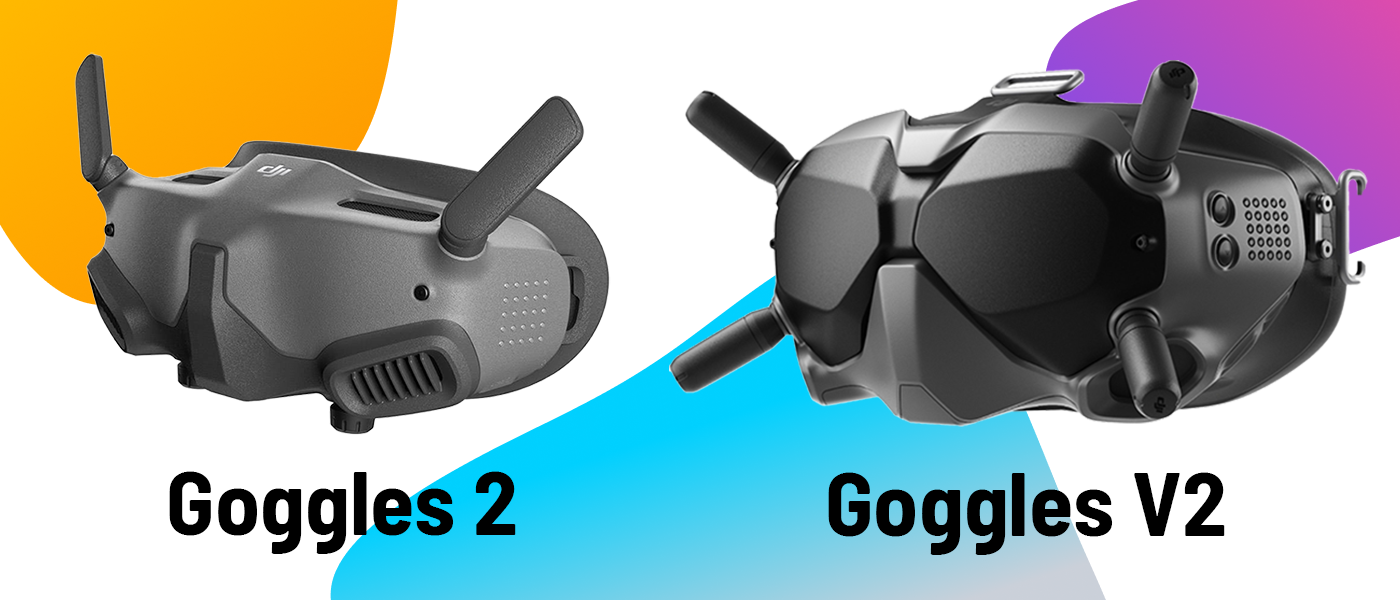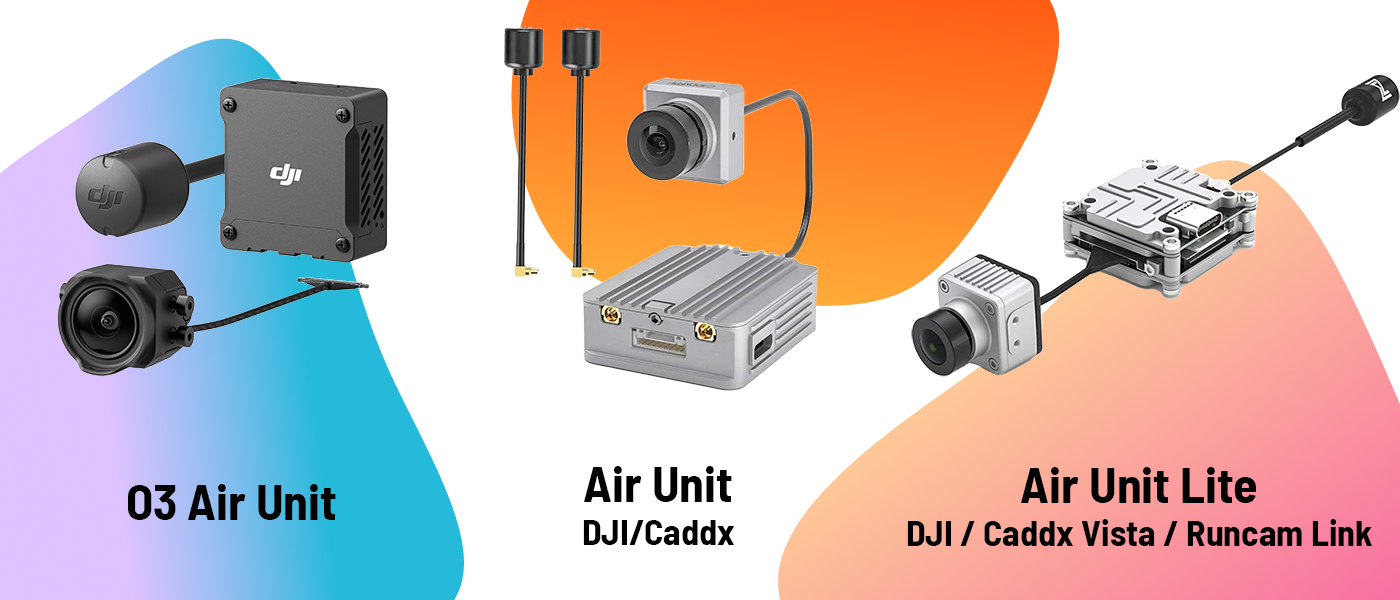Comparing the DJI Goggles 2 and O3 Air Unit Against Goggles V2
Comparing the new DJI FPV Goggles 2 and O3 System with the Goggles V2 System

DJI has finally released the FPV Goggles 2, not to be confused with the Goggles V2. This is the most anticipated and significant update to DJI's FPV system since the FPV Goggles V1 were released back in 2019.
In this issue, we're covering the specs of the very latest DJI FPV Goggles 2, the O3 Air Unit and Camera. We compare DJI's latest flagship FPV ecosystem to the V2 and V1 Goggles, including compatibility between all the Air Units and goggles.

How Do the DJI FPV Goggles 2 Compare With the Goggles V2 and Goggles V1?
The Goggles 2 are a significant update to the V2 and V1s. The Goggles 2 support 1080p Live View and a higher refresh rate. It's 36% lighter, and comes in a smaller form factor with foldable antennas.
The biggest improvement in the Goggles 2 is the 1080p OLED screens. If you're someone who cares deeply for improved optics and image quality, the Goggles 2 won't disappoint.
If you're new to FPV and looking for the most compatibility, the V2 Goggles are still the winner. They work with the O3 Air Unit, all of the current Air Unit and Air Unit Lites, and the Avata drone. Currently, the Goggles 2 are only compatible with the O3 Air Unit and Avata drone. If you're considering an Avata drone, you can consider the older Goggles V2 kit because it's cheaper and compatible with all DJI Air Units.
Due to the 5.8GHz single-band hardware, the Goggles V1 are not compatible with the O3 Air Units. Is this update worth upgrading from the Goggles V1 to the Goggles 2? The answer to this is highly use-case specific, but in general, while Air Units and Air Unit Lites are still readily available, we don't see a reason to overhaul your VTX system yet.
See a side-by-side comparison of all the Goggle specs below:
| Goggles 2 | Googles V2 | Goggles V1 | |
|---|---|---|---|
| Release Date | Sept 2022 | March 2021 | July 2019 |
| Price | $569 | $429 | n/a, was $569 |
| Screen Refresh Rate | 100Hz | 144Hz | 120Hz |
| Live View Mode (Low Latency) | 1080p @ 100fps | 810p @ 120fps | 720p @ 120fps |
| Live View Mode (High Quality) | 1080p @ 60fps | 810p @ 60fps | 720p @ 60fps |
| Transmission Frequency | 2.4GHz & 5.8GHz | 2.4GHz & 5.8GHz | 5.8GHz |
| Screen Resolution | 1920 x 1080p (OLED) | 1440 x 1080p (LCD) | 1440 x 1080p (LCD) |
| FOV | 51° | 30° - 54° | 30° - 54° |
| IPD Range | 56 - 72mm | 58 - 70mm | 58 - 70mm |
| Video Format | H.264, H.265 | H.264 | H.264 |
| - | |||
| V1 Air Unit Compatibility* | No | No | Yes |
| 03 Air Unit Compatibility | Yes | Yes | No |
| - | |||
| Weight | 290g | 420g | 420g |
| Dimensions with Antenna | 197 x 105 x 103 mm | 202 x 126 x 110 mm | 202 x 126 x 110 mm |
| Dimensions w/o Antenna | 167 x 79 x 103 mm | 184 x 122 x 110 mm | 184 x 122 x 110 mm |
| Battery Input Voltage | Included 2S 1800mAh | up to 25.2V (2S - 6S) | up to 17V (2S - 4S) |
| Video Out Support | USB-C | USB-C | USB-C |
*V1 Air Units include the Air Unit Lites, which consist of Caddx Vista and RunCam Link.

How Does the O3 Air Unit Compare With the Air Unit V1 and Air Unit Lite (Vista)?
The latest Air Unit comes with a lot more features and its total weight measures in between the Air Unit and Air Unit Lite. The biggest difference in the O3 is the ability to record on-board DVR at 4K. With video quality that compares to that of some GoPros, expect a lot of people to adopt the O3 Air Unit just to shave off the extra weight, which will result in better maneuverability and flight time.
The O3 Air Unit has a 25.5 x 25.5 mm whoop mount, so it will fit in most standard 5-inch quads and 3-inch cinewhoops.
The O3 Air Unit comes with dual IPEX antenna connectors and the included hardware includes both antennas in a single housing.
If you're someone who wants to replace the GoPro on your quad, the O3 system is a great VTX option.
Unlike other VTX systems like HDZero and Avatar, DJI currently only offers the O3 system in this Air Unit form factor, which will be prohibitively heavy for certain use cases like tiny whoops.
Compare the new O3 Air Unit specs with the Original Air Unit and Caddx Air Unit Lites below:
| O3 Air Unit | Air Unit | Air Unit Lite | |
|---|---|---|---|
| Release Date | November 2022 | July 2019 | January 2020 |
| Price | ~$250 - 300 | ~$220 | ~$185 |
| Weight with camera | 35.7g | 45.8g | 29g |
| Dimensions | 32.5 ×30.5 ×14.5 mm | 44 x 37.8 x 14.4 mm | 30 x 29 x 13 mm |
| Mount | 25.5 x 25.5 mm | Non-standard | 20 x 20 mm |
| Operating Frequency | 2.4GHz and 5.8GHz | 5.8GHz | 5.8GHz |
| DVR Resolution | 4K @ 50/60fps | 720p @ 120fps | No DVR Onboard |
| Minimal Latency w Goggles 2 | Low Latency Mode: <28ms High Quality Mode: <40ms | ||
| Minimal Latency w Goggles V2 | Low Latency Mode: <30ms High Quality Mode: <40ms | Low Latency Mode: <28ms High Quality Mode: <40ms | Low Latency Mode: <28ms High Quality Mode: <40ms |
| Max Transmission Distance | FCC: <10km; CE: <2km; SRRC: <6km | FCC/SRRC: 4km; CE: 0.7km | FCC/SRRC: 4km; CE: 0.7km |
| Power Output | Unspecified | Up to 700mW | Up to 700mW |
| Antenna type | IPEX/U.FL | MMCX | IPEX/U.FL |
How Does the DJI O3 Camera Compare to the Existing Options?
The new O3 camera is also a significant update from the first DJI camera and third party cameras in that it now has stabilization built in and is meant to serve as both the FPV camera and HD action camera. This means that you can get high quality footage without strapping on an additional GoPro or high definition camera.
Like the original DJI Camera, the O3 Camera comes with a non-standard mount. It's closest in size to 19x19mm micro mounts, but with two screws. And depending on the clearance between your standoffs and FPV camera, the new O3 Camera may be too big to mount in place, or adjusted after it's installed. We can expect frame makers to design new frames and adapters to work with the O3 Camera.
The video quality coming from the new 1/1.7 CMOS sensor rivals footage coming from GoPros. The footage from the O3 camera can be stabilized natively with DJI's RockSteady. While the footage can't be fed through ReelSteady, it can be used in Gyroflow for more specific stabilization needs.
Here are the specs of the new DJI Camera compared to widely-used FPV cameras available today:
| DJI O3 Camera | DJI FPV Camera | Caddx Nebula Pro | Runcam Phoenix HD | |
|---|---|---|---|---|
| Release Date | November 2022 | 2019 | 2021 | 2021 |
| Price | $109 | $65 | $67 | $55 |
| Mount Size | Micro 20x20 mm |
Micro 20x20 mm |
Nano 14x14 mm |
Micro 19x19 mm |
| Dimensions | 21.2 × 20 × 19.5 mm | 22.1 x 21.1 x 20.1 mm | 16.5 x 16 x 14 mm | 19 x 19 x 23.5 mm |
| Weight | 8.3g | 8.2g | 3.5g | 7.5g |
| Sensor | 1/1.7" CMOS | 1/3.2" CMOS | 1/3" CMOS | 1/2" CMOS |
| Lens | 2.34mm, f/2.8 | 2.1mm, f/2.8 | 2.1mm, f/2.1 | |
| FOV | 155° | 150°(D); 122°(H); 93°(V) | 150°(D); 122°(H); 93°(V) | 157°(D); 133°(H); 72°(V) |
| Stabilization | RockSteady 2.0, HorizonSteady | N/A | N/A | N/A |
Will you be upgrading or starting with the Goggles 2? What about the Goggles 2 makes it a buy or no buy for you?
Spec out your next quad on QuadPartPicker.
